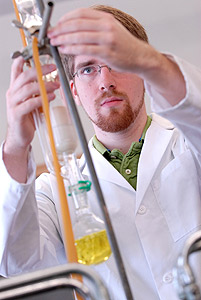 Augsburg University has been successful in securing grants and funding from a wide array of government and public funding sources, including the U.S. Dept. of Education, National Institute of Justice, National Science Foundation, Hartford Foundation, and the Kemper Foundation. Augsburg has been ranked consistently as one of the top recipients of funding from the National Science Foundation in Minnesota. To find out more about grants and research at Augsburg, visit our grants page.
Augsburg University has been successful in securing grants and funding from a wide array of government and public funding sources, including the U.S. Dept. of Education, National Institute of Justice, National Science Foundation, Hartford Foundation, and the Kemper Foundation. Augsburg has been ranked consistently as one of the top recipients of funding from the National Science Foundation in Minnesota. To find out more about grants and research at Augsburg, visit our grants page.
In addition, Augsburg’s faculty work with students on a wide range of research projects each year. Faculty and students receive support from the Office of Undergraduate Research and Graduate Opportunity.
Nanoparticle Student Summer Research Project
Working with Vivian Feng, associate professor of chemistry, Yemissrach (Yemi) Melka spent a summer studying the efficiency of nano-partials as catalysts within a model chemical reaction.
History Department receives $82,486 for Historyapolis Project
Dr. Michael Lansing, Associate Professor and Chair of the History Department, and Dr. Kirsten Delegard, Scholar-in-Residence, were awarded $82,486 from the Minnesota Historical Society through the State of Minnesota’s Historical and Cultural Heritage Fund for their Historyapolis Project. This is the first time that an academic department of history has received funding from this program for such a project.
Minneapolis currently has no central clearinghouse where citizens can discover the full history of the state’s largest city. The Historyapolis Project seeks to remedy this situation. Animated by the belief that history is a powerful tool for community-building, this initiative will use digital tools to make the city’s history more accessible, catalyzing community dialogue around some of the most challenging aspects of the past in Minneapolis.
The Historyapolis Project seeks to make Augsburg University the leading center for Minneapolis history. It also plans to give Augsburg students practical opportunities to do local history and learn digital skills.
The award funds cover the cost of one year of research for a team of faculty and student researchers. Historyapolis researchers will work work in local and national repositories to gather material. The team will share the results of this work through the project Facebook page and website: www.historyapolis.com. At the end of the year, the project will publish an annotated bibliography that will serve as a roadmap for future researchers looking to explore the history of the city. The team expects that this document will be used by teachers, students, citizen researchers and professional historians looking to explore aspects of the city’s history.
This project has been financed in part with funds provided by the State of Minnesota from the Arts and Cultural Heritage Fund through the Minnesota Historical Society.
If you would like to learn more about this project, please feel free to contact Dr. Lansing at lansing at augsburg.edu or Dr. Delegard at delegard at augsburg.edu.
Engebretson and MACCS team receive $425,919 grant from National Science Foundation
The National Science Foundation has awarded a new three-year $425,919 research grant (NSF AGS-1264146) to Augsburg University’s Physics Department for continued operation of the Magnetometer Array for Cusp and Cleft Studies (MACCS), a longitudinally-extended array of 8 magnetometers located in Arctic Canada, and for space science research based on MACCS data.
In addition to funding for field operations and scientific analysis, this new grant will continue to support undergraduate research. Two undergraduate students will work each summer with members of the MACCS team, which includes: Mark Engebretson, Professor of Physics and Principal Investigator; David Murr, Associate Professor of Physics and Co-Principal Investigator; Viacheslav Pilipenko, Visiting Faculty and Co-Principal Investigator; Jennifer Posch, Assistant Scientist; Laura Simms, Physics Research Assistant; and Erik Steinmetz, Computer Science Instructor.
Originally installed in 1992/93, the MACCS array detects magnetic variations and electrical currents that originate near the boundary between Earth’s magnetosphere and the solar wind and propagate along magnetic field lines that reach Earth’s surface at high latitudes. High time resolution GPS receivers installed at two MACCS sites in the past 3 years augment these magnetometers, and make it possible to study motions of the high-latitude ionosphere. The MACCS array has provided data to space scientists worldwide: since 2003, over 50 refereed research papers focusing on the dynamics of Earth’s space environment have used MACCS data or were theoretical studies supported by MACCS grants.
If you would like to learn more about this project, please contact Mark Engebretson at engebret at augsburg.edu.
Editor’s Note: This material is based upon work supported by the National Science Foundation under Grant No. AGS-1264146. Any opinions, findings, and conclusions or recommendations expressed in this material are those of the author(s) and do not necessarily reflect the views of the National Science Foundation.
